On November 3, 2021, Jerome Powell made it clear the Fed only cares about “stonk” prices – and here’s how we see this as relevant to the possible rate hike in 2022. Employment is just an excuse to keep the monetary pedal to the metal.
While his concern for the labor situation seems legitimate, if you peel back the onion, it appears he might have an ulterior motive for not raising rates.
The potential motive lies in the following statement:
As we show in this article, the economy is pretty much at maximum employment. Inflation is running red hot and increasingly showing signs it may be persistent. Having neglected one mandate and largely fulfilled the other, why is the Fed so slow to reduce asset purchases and unwilling to contemplate a rate hike in 2022?
Before we answer the question, we share data on the two congressionally chartered Fed mandates, price stability, and maximum employment. Examining the data shows there is something else accounting for recent Fed’s policy actions, or better said, lack of action.
Price Stability
“The risk is skewed now, and it appears to be skewed toward higher inflation”
“Overall inflation is running well above our 2% longer-run goal.”
Powell is crystal clear at his November 3, 2021, press conference that inflation is running hot. No one in their right mind can say the Fed is meeting their mandate for “stable prices.”
The graph below shows seven indicators of annual inflation rates. We use standard deviation, or sigma, to normalize the seven measures. They are all overextended significantly. In other words, there a very few instances of higher inflation than today in the last 30 years.
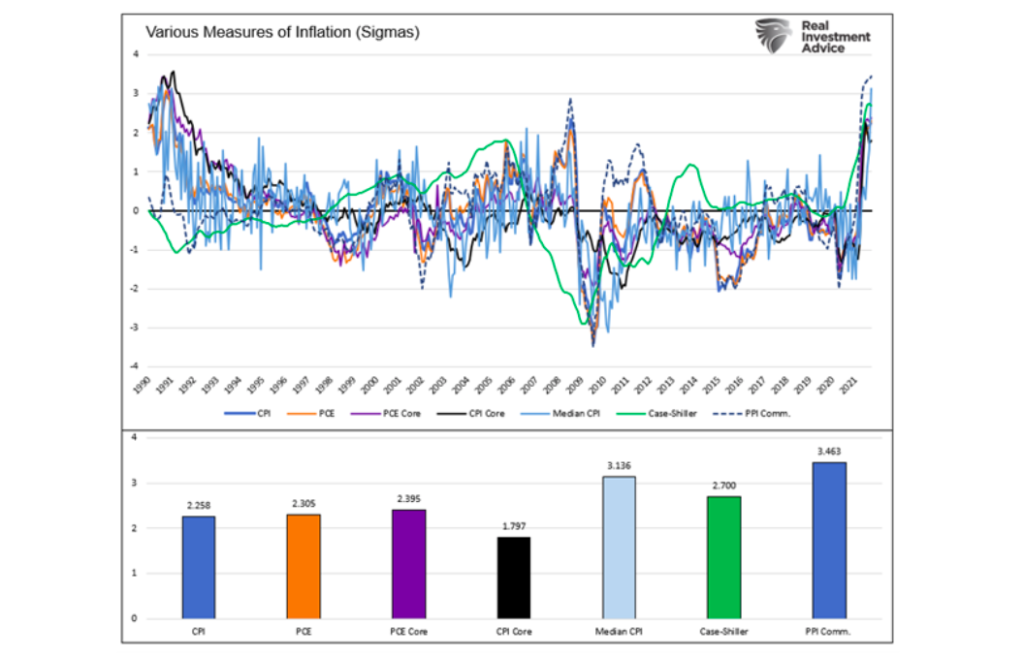
On the sole basis of prices, the Fed should be aggressively removing crisis-level monetary accommodations and enacting a rate hike in 2022 to make prices “stable.”
Senator Rick Scott of Florida, in a letter to Chairman Powell, agrees: “Today, American families are faced with rising prices and inflation not seen in 30 years – this is surely not ‘price stability.’
Maximum Employment
Inflation is relatively easy to measure with a single number. While we may question the veracity of any inflation figure, we can all agree prices are rising. Employment is not so easy to measure.
“So maximum employment is, we say broad-based and inclusive goal that’s not directly measurable and changes over time due to various factors. You can’t specify a specific goal. So it’s taking into account quite a broad range of things. And of course, levels of employment, participation are part of that.”- Jerome Powell 11/3/2021
The pandemic changed behaviors making some data even more challenging to assess. As such, let’s review traditional and alternative data and see if employment is back to normal.
The Unemployment Rate
As shown below, the popular U3 Unemployment Rate, at 4.6%, is only 0.2% above the average of the five years preceding the pandemic. One can argue that period was abnormal as it posted the lowest level of unemployment since the 1960s.
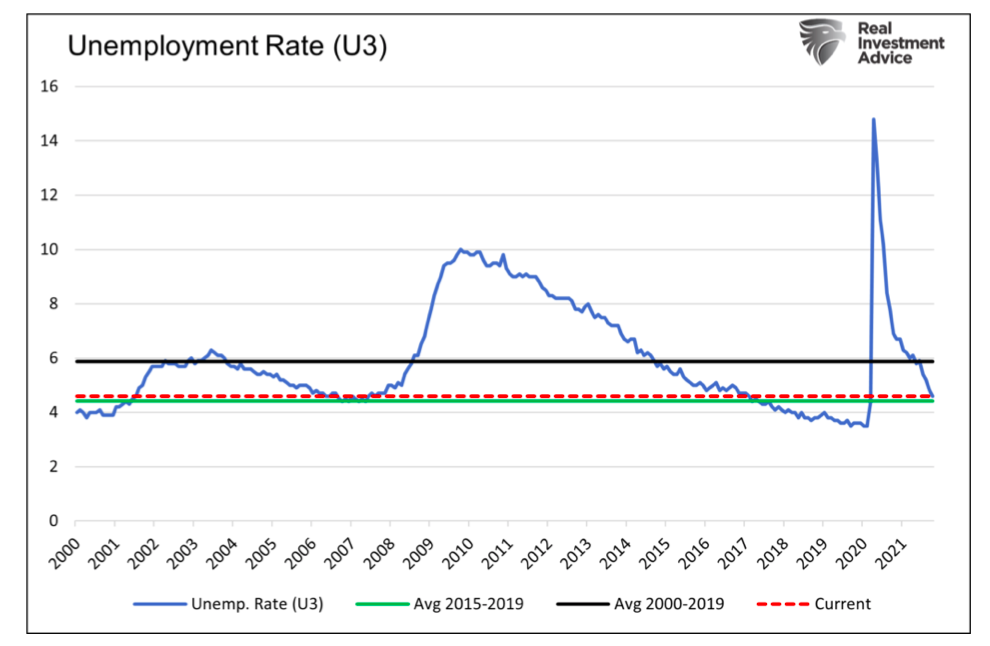
The U6 Unemployment Rate is not as well followed as the U3 shown above. U6 includes those unemployed in the U3 number but also those underemployed and discouraged from seeking jobs. Jerome Powell thinks the U6 figure is a more credible indicator given the pandemic-related dislocations. As shown below, the U6 rate is 0.4% below the average of the five years leading to the pandemic.
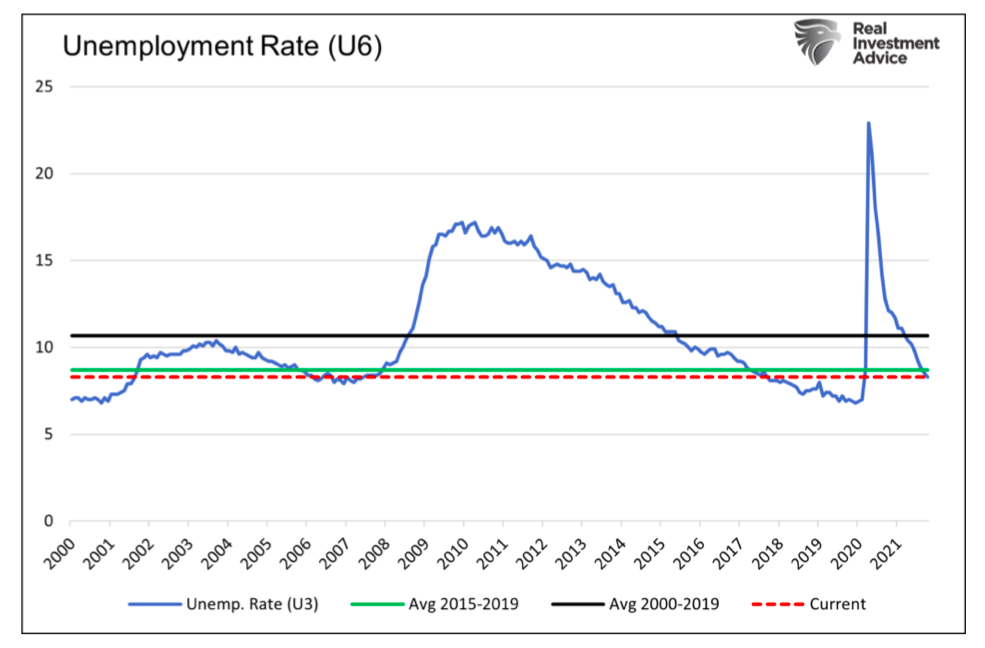
Both traditional measures show the Fed has met its employment mandate.
Labor Participation Rate
Jerome Powell uses the word “participation” seven times in his most recent press conference. The paragraph below has three of them.
“The unemployment rate was 4.8% in September. This figure understates the shortfall in employment, particularly as participation in the labor market remains subdued. Some of the softness in participation likely reflects the aging of the population and retirements, but participation for prime-aged individuals also remains well below pre-pandemic levels.”
In his mind, a weak labor participation rate is a sign of labor weakness. The BLS calculates the Labor participation rate by dividing the labor force by the total working-age population.
The graph below shows the labor participation rate is about 1.5% below pre-pandemic levels.
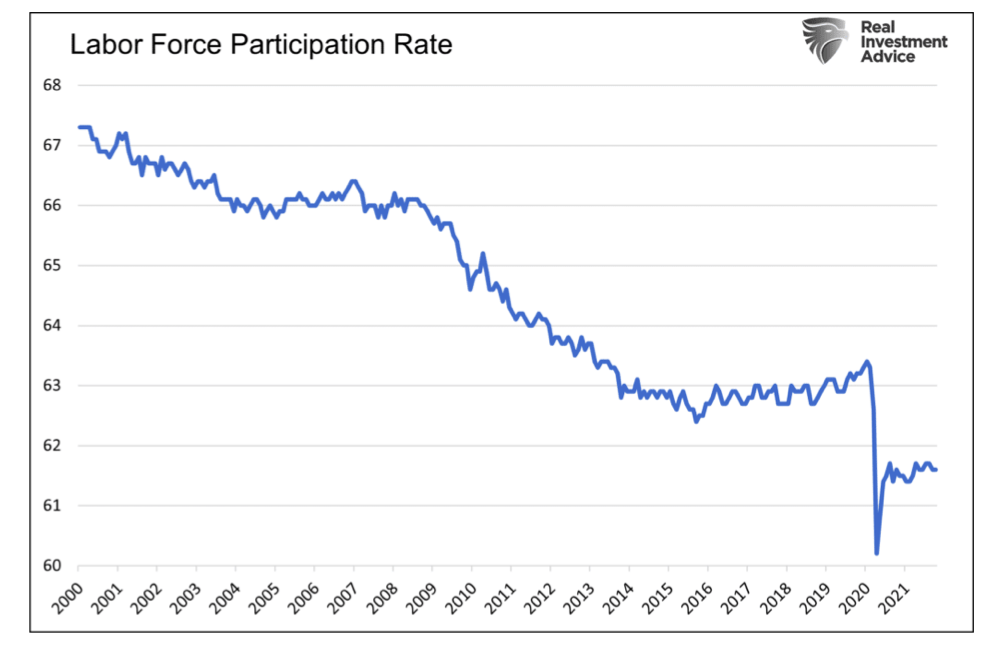
Why?
Why are some measures of employment back to normal yet the participation rate slow to recover?
People have left jobs for several reasons. In many instances, it appears people are voluntarily leaving their jobs. For example, some parents are now staying at home with their kids. In other cases, those on the cusp of retiring retired from their jobs. More recently, the number of people quitting jobs is increasing, as workers look for a better or higher-paying job.
- The female labor force participation rates show that women aged 35-44 is still down about 3% from pre-pandemic levels. The participation rate for women aged 25-34 is down about half a percent. Women aged 35-44 are much more likely to have school-aged children than the younger cohort.
- The Wall Street Journal graph below shows the share of the population that retired since the pandemic rose by about half a percent above its trend.
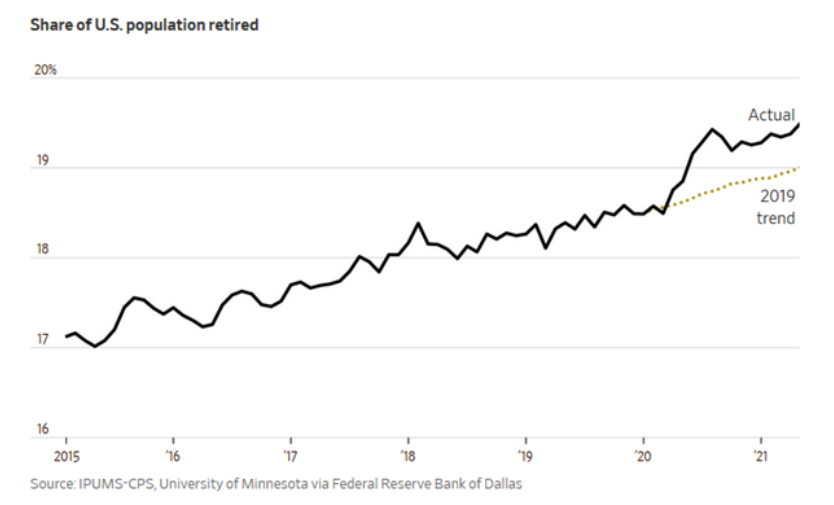
The graph below shows, the Labor Quits rate is up .6% since the pandemic started.
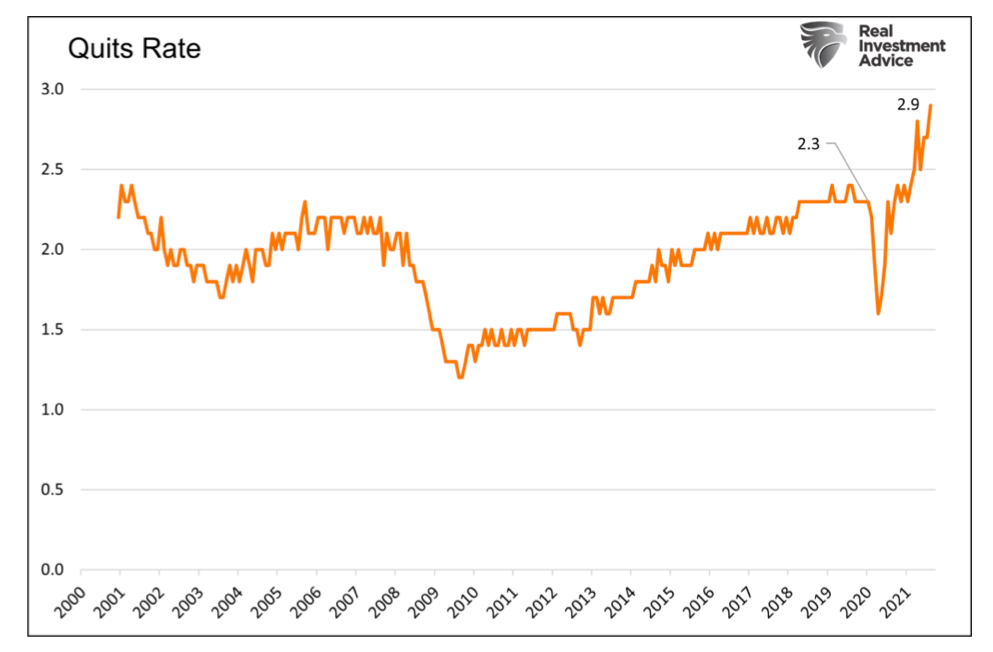
While difficult to quantify, when adjusted for voluntary actions, like those above, the participation rate is likely back to where it was before the pandemic.
Job Openings
Other alternative indicators are telling us the labor market is robust as well. For instance, the graph below shows there are 1.7 jobs available for every person that lost a job during the pandemic. The data lags BLS data but will likely show further improvement in the months ahead.
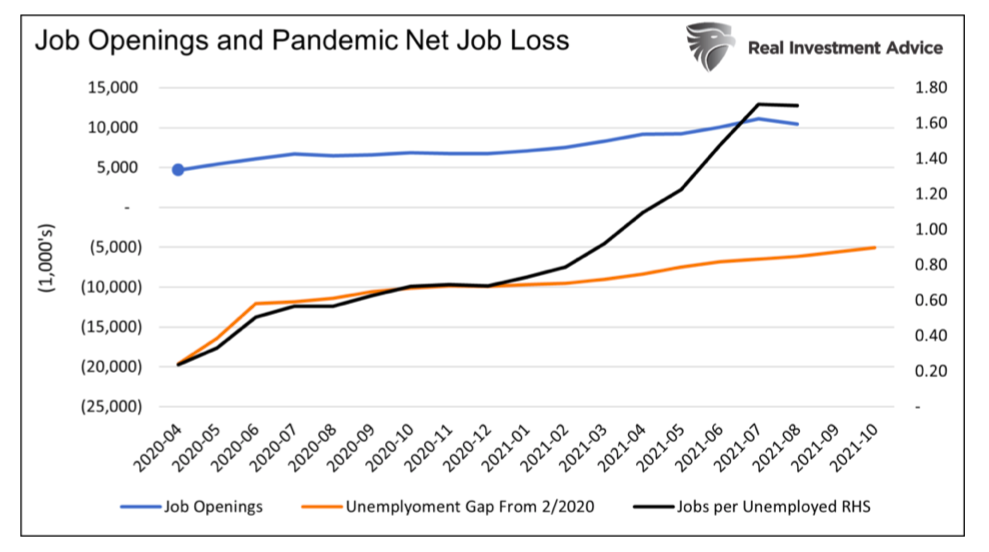
The labor market is fully recovered for those willing and able to work. The Fed has met its mandate.
It’s All About “Stonks”
Stonks is a meme that purposely misspells stocks. The term is used on social media to imply many stock traders have a vague understanding of the stock market. The preponderance of amateur “Stonk” investors helps explain why valuations are extreme and disconnected from reality.
The Fed, through its operations, fosters such a speculative and, dare we say, reckless environment. For more on this, please read The Fed is Juicing Stocks.
Regardless of whether it is direct or indirect, the “Fed put” encourages risk-taking. Why not buy more “stonks” and take on more risk? The Fed has your back in the event of a downdraft. This was true once again in March of 2020.
Let’s revisit a Powell quote: “The Fed’s policy actions have been guided by our mandate to promote maximum employment and stable prices for the American people along with our responsibilities to promote the stability of the financial system.”
More specifically, he states: “Our asset purchases have been a critical tool. They helped preserve financial stability early in the pandemic. And since then, have helped foster smooth market functioning and accommodate financial conditions to support the economy.”
Financial stability and smooth market functioning translate to higher asset prices. Paradoxically, at current extreme valuations, financial markets are now more unstable than at just about any other time in history.
This is not news to the Fed. In their most recent Financial Stability Report, they note – “Asset prices remain vulnerable to significant declines should investor risk sentiment deteriorate.”
Investor risk sentiment is very sensitive to Fed’s actions. You do the math, it’s all about “stonks, stonks, and more stonks.”
From The Horses Mouth
If you do not believe us listen to them.
The following editorial is from the guy that ran QE operations for the Fed.
“I can only say: I’m sorry, America. As a former Federal Reserve official, I was responsible for executing the centerpiece program of the Fed’s first plunge into the bond-buying experiment known as quantitative easing. The central bank continues to spin QE as a tool for helping Main Street. But I’ve come to recognize the program for what it really is: the greatest backdoor Wall Street bailout of all time.” – Andrew Huszar 2013 –LINK
Summary on the possibility of a rate hike in 2022
Powell’s rationale for not reducing QE quicker or raising rates is either a lie or poor analysis. Either way, the labor market is nearly as strong as any time in the last thirty years.
Prices are far from stable. Inflation is running hot, and the odds of supply-related shortages putting pressure on prices seem to grow by the day.
While markets seem calm and healthy, valuations portend they are incredibly risky.
Based solely on the two Fed mandates and their “responsibility” to “foster smooth market functioning” they should halt QE immediately and implement a rate hike in 2022 at the latest.
They won’t because doing so would harm the financial markets, and that it seems trumps everything at the Fed.
Twitter: @michaellebowitz
The author or his firm may have positions in mentioned securities at the time of publication. Any opinions expressed herein are solely those of the author, and do not in any way represent the views or opinions of any other person or entity.








